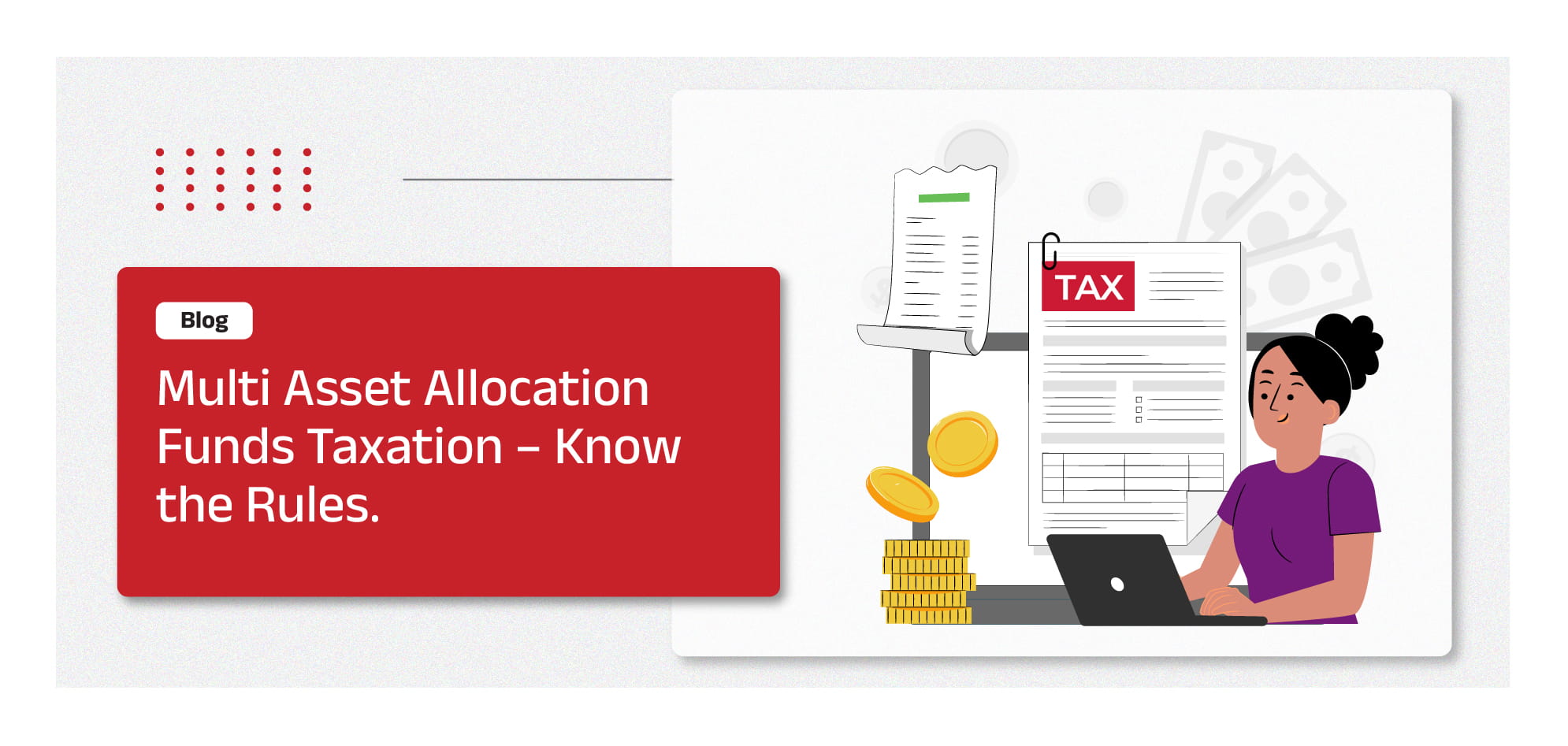-
Our Products
Our FundsFocus Funds
-
Self Care
Self-ServiceFind InformationWays To TransactPartner Solutions
-
Downloads
- Learnings
- About Us
-
More
-
Shareholders
-
Shareholders
-
Updates
-
-
SIP Calculators
- Back
-
Shareholders
Multi Asset Allocation Funds Taxation – Know the Rules

Apr 23, 2025
5 Min
0 Rating
When investors are looking to diversify within a single investment, they often turn to multi-asset allocation funds. These funds are invested across different asset classes, such as debt instruments, equities, gold, etc, to balance risk and return. However, taxation on this fund is slightly different from pure equity or debt funds and understanding it can be complicated. Read on to learn the concept of taxation of multi-asset allocation fund.
What are Multi Asset Allocation Funds?
Multi-asset allocation funds are a mutual fund category that invests in at least three different asset classes, the minimum allocation being 10% in each. With multi-asset allocation funds, investors can have a diversified portfolio, which helps them navigate volatile market conditions while maintaining stable returns.
The primary assets in a multi-asset allocation fund are:
Equities
Debt instruments (like bonds, government securities, etc)
Commodities (like gold, real estate, etc)
Fund managers have the flexibility to adjust allocation based on market trends and economic conditions beyond the minimum 10% allocation in each asset class, which makes multi-allocation funds highly dynamic.
Different fund houses offer multi-asset allocation funds with different asset compositions.
Domestic equity exposure refers to the proportion of a fund’s total investments allocated to Indian equities (stocks of companies listed on Indian stock exchanges). A higher domestic equity exposure means that stock market movements influence the fund more. On the other hand, a lower exposure indicates a more balanced or conservative approach.
One must note that if the equity exposure exceeds 65%, then the fund scheme is taxed like an equity fund. If it is less, then the rules of taxation of debt funds apply.
Who Should Invest in Multi-Asset Allocation Funds?
Multi-asset allocation mutual funds are suitable for investors who do not tend towards higher-risk investments and have a low to moderate risk appetite but also wish to enjoy ret urns on their investments.
This asset allocation enables investors to minimise the risks of investing in only a single asset class.
Furthermore, it ensures a flow of income for the investors, even when some of their asset classes are performing lower than usual.
How are Multi-Asset Allocation Funds Taxed?
The taxation of multi-asset allocation funds depends upon the average equity allocation over the financial year. Multi-asset funds can be taxed under three different scenarios, unlike equity or debt funds, which are based on their equity exposure.
Tax treatment based on equity allocation is as follows :
Equity Exposure (%) |
Short-Term Capital Gains (STCG) |
Long-Term Capital Gains (LTCG) |
65% or more (Equity Fund) |
T axed at 15% (if units are sold within 12 months) |
Taxed at 10% (on gains above ₹1 lakh)+ 4% cess |
Between 35% - 65% (Non-Equity Fund Type 1) |
Taxed as per the investor’s income tax slab (if sold within 3 years) |
Taxed at 20% with indexation (if held for more than 3 years) |
35% or less (Non-Equity Fund Type 2) |
Taxed as per the investor's tax slab |
Taxed at 20% with indexation benefits (if held for more than 3 years) |
Let us understand each of them in detail:
Funds with 65% or more equity exposure
If the fund maintains 65% or more in equities, it is treated as an equity fund for tax purposes
STCG (if units are sold within one year), taxed at 15% + 4% cess
LTCG (if units are held for more than one year), taxed at 10% + 4% cess on gains exceeding ₹1 lakh (no indexation benefit)
Funds with 35% or less equity exposure
These are non-equity funds (type 2)
STCG gains (if sold within 3 years) are taxed as per the investor’s income tax slab.
LTCG gains (if held for more than 3 years) are taxed at 20% with indexation benefits.
Note: As per the Finance Act, 2024, the indexation benefit has been removed for long term mutual fund categories (classified as "Specified Mutual Funds") for investments made on or after July 23, 2024.
An Example to Understand Taxation
Let’s assume an investor redeems ₹2,00,000 worth of units from a multi-asset allocation fund after two years and the funds. The average equity exposure over the past 12 months was 70%.
Since the fund qualifies as an equity fund, the first ₹1,00,000 of capital is tax-free
The remaining one lakh is taxed at 10%, resulting in a tax liability of ₹10,000. If the same fund had 40% equity exposure, it would be taxed at 20% with an index benefit.
Final thoughts
With multi-asset allocation funds comes diversification and stability, making them a suitable option for investors with a low or moderate risk appetite. However, the taxation process of multi-asset allocation funds can be complex, depending on their equity allocation over a year (12 months). Investors must monitor their fund's equity composition to estimate the applicable tax and make strategic investment decisions.
The Tax calculation shown above is for illustration purpose and general information only. Amount(s) mentioned above may undergo a change if assumptions specified herein do not hold good. Investors are advised to read the scheme information document of the scheme carefully before investing and consult their Tax Consultant or Financial Advisor to determine tax benefits applicable to them.
Mutual Fund investments are subject to market risks, read all scheme related documents carefully.





 1800-270-7000
1800-270-7000



